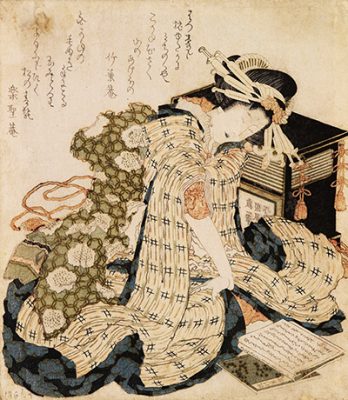Hokusai
Courtesan Asleep by Hokusai
Courtesans or women of pleasure is synonymous with Japanese history because prostitution has been in prevalence for as long as the country existed. In fact, courtesans are also commonly compared to geishas although the two are very different.
Geishas are referred to as willows in Japan as they are a strong representation of strength, grace and subtlety whereas courtesans are nicknamed ‘colorful flowers’ because of their vivacity and high spirits and of course their ability to give pleasure. In the painting Courtesan Asleep by Japanese printmaker, ukiyo-e painter and artist Hokusai, we see a courtesan in a not-so-typical setting.
Here we observe a young courtesan, heavily dressed and decked up with hair ornaments, taking a nap or sleeping whilst resting her head on a table. There are two books in front of her, one of them is opened, thereby depicting that she must have been reading before falling asleep. The books render a special touch to the painting in the sense that they portray the intellectual aspect of the courtesan. The painting also contains some scribbling at the top. The lady-like pose, beautiful dress and Japanese aspects in the painting such as the decorative knots on the side of the table all blend together beautifully to form a tasteful and impressive painting.
Born in Tokitaro during the Edo period, Katsushika Hokusai is one of the most popular painters or artists of all time. Apart from Courtesan Asleep, he is known for many other works, some of which has also received international acclamation. For instance, his woodblock print series titled ‘Thirty-six views of Mount Fuji’ houses the iconic print ‘The Great Wave off Kanagawa’ which is widely known throughout the world. In fact, many would consider this print as the painter’s most famous print. Whilst he stuck with the typical subjects of ukiyo-e, i.e. courtesan in the painting Courtesan Asleep, he moved on to painting landscapes as well as images of daily life of Japanese people from across different social levels. Apart from these, Hokusai also engaged in Shunga or erotic art, something that was appreciated and enjoyed by people of all classes, both men and women. It is also said that these Shunga paintings (by Hokusai as well as other painters) played the role of a sexual guide for children from wealthy families.
